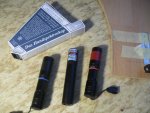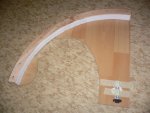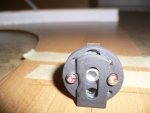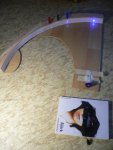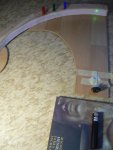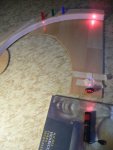Krutz
0
- Joined
- Nov 21, 2007
- Messages
- 1,733
- Points
- 48
hi everybody!
just want to share what i have been up to last days..
you surely all know those "magic googles" (no, not those x-ray-googles!) you find in cereal boxes sometimes, those which make everything look colorful.
like here: http://astromedia.de/shop/images/MSF+Kerze1.jpg
they perhaps are the most common use of gratings. gratings are either reflective or transmissive. the transmissive is a foil or glassplate with many parallel lines on it. the reflective one is the same, with a mirror behind.
so everything i say about transmissive ones is valid for reflective ones too. here i will be talking about (my) transmissive grating. the distance between the lines is in the order of 1000 to 5000 nm, that is 500 to 1000 lines per millimeter! looking at one, it looks transparent, with a slight "oil-film" appearance.
the funny thing with those is:
-shine a (laser-) beam through it, it will go straight through
-a second (and third) dot will be visible next to the original dot
the distance between those two dots (the angle in fact) depends on the wavelength.
a blue dot will be nearer to the original dot than a red one.
so far for the theory.
some time ago, i bought some handheld-diy-cardboard spektroskopes here
http://astromedia.de/shop/csc_fullview.php?Artikelnummer=406.hsp (german)
with that, you can nicely analyse different lightsources, like actually seeing how a CRT monitor lights, the difference between candles, incan, leds, hid and fluorescent tubes. it is quite accurate, since you cant really screw up the sensitive distances in this build-up. 10$, one hour building.
i took the grating from a second (or was it third?) one, and built me a bigger spektroskope for analysing laserwavelengths. bigger to be able to measure on a bigger scale, and different setup, to not look directly into laserbeams!
first pic is the cardboard-model and some lasers.
just want to share what i have been up to last days..
you surely all know those "magic googles" (no, not those x-ray-googles!) you find in cereal boxes sometimes, those which make everything look colorful.
like here: http://astromedia.de/shop/images/MSF+Kerze1.jpg
they perhaps are the most common use of gratings. gratings are either reflective or transmissive. the transmissive is a foil or glassplate with many parallel lines on it. the reflective one is the same, with a mirror behind.
so everything i say about transmissive ones is valid for reflective ones too. here i will be talking about (my) transmissive grating. the distance between the lines is in the order of 1000 to 5000 nm, that is 500 to 1000 lines per millimeter! looking at one, it looks transparent, with a slight "oil-film" appearance.
the funny thing with those is:
-shine a (laser-) beam through it, it will go straight through
-a second (and third) dot will be visible next to the original dot
the distance between those two dots (the angle in fact) depends on the wavelength.
a blue dot will be nearer to the original dot than a red one.
so far for the theory.
some time ago, i bought some handheld-diy-cardboard spektroskopes here
http://astromedia.de/shop/csc_fullview.php?Artikelnummer=406.hsp (german)
with that, you can nicely analyse different lightsources, like actually seeing how a CRT monitor lights, the difference between candles, incan, leds, hid and fluorescent tubes. it is quite accurate, since you cant really screw up the sensitive distances in this build-up. 10$, one hour building.
i took the grating from a second (or was it third?) one, and built me a bigger spektroskope for analysing laserwavelengths. bigger to be able to measure on a bigger scale, and different setup, to not look directly into laserbeams!
first pic is the cardboard-model and some lasers.


